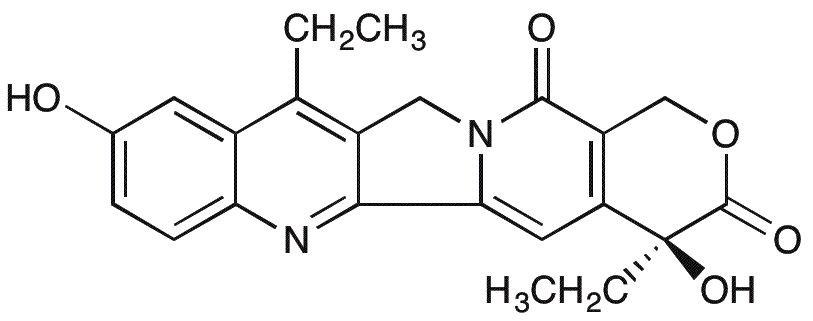7-Ethyl-10-hydroxycamptothecin is widely utilized in research focused on:
- Cancer Treatment: This compound is being investigated for its potential as an anti-cancer agent, particularly in treating various types of tumors. Its ability to inhibit DNA topoisomerase I makes it a promising candidate in oncology.
- Pharmaceutical Development: Researchers are exploring its formulation in drug delivery systems, enhancing the bioavailability of cancer therapies. This could lead to more effective treatments with fewer side effects.
- Combination Therapies: It is being studied in combination with other chemotherapeutic agents to improve treatment efficacy and reduce drug resistance in cancer cells.
- Biological Research: The compound serves as a valuable tool in cellular and molecular biology studies, helping scientists understand the mechanisms of cancer cell proliferation and apoptosis.
- Natural Product Synthesis: Its structure inspires synthetic chemists to develop new analogs with improved therapeutic profiles, potentially leading to novel cancer treatments.
General Information
Properties
Safety and Regulations
Applications
7-Ethyl-10-hydroxycamptothecin is widely utilized in research focused on:
- Cancer Treatment: This compound is being investigated for its potential as an anti-cancer agent, particularly in treating various types of tumors. Its ability to inhibit DNA topoisomerase I makes it a promising candidate in oncology.
- Pharmaceutical Development: Researchers are exploring its formulation in drug delivery systems, enhancing the bioavailability of cancer therapies. This could lead to more effective treatments with fewer side effects.
- Combination Therapies: It is being studied in combination with other chemotherapeutic agents to improve treatment efficacy and reduce drug resistance in cancer cells.
- Biological Research: The compound serves as a valuable tool in cellular and molecular biology studies, helping scientists understand the mechanisms of cancer cell proliferation and apoptosis.
- Natural Product Synthesis: Its structure inspires synthetic chemists to develop new analogs with improved therapeutic profiles, potentially leading to novel cancer treatments.
Documents
Safety Data Sheets (SDS)
The SDS provides comprehensive safety information on handling, storage, and disposal of the product.
Product Specification (PS)
The PS provides a comprehensive breakdown of the product’s properties, including chemical composition, physical state, purity, and storage requirements. It also details acceptable quality ranges and the product's intended applications.
Certificates of Analysis (COA)
Search for Certificates of Analysis (COA) by entering the products Lot Number. Lot and Batch Numbers can be found on a product’s label following the words ‘Lot’ or ‘Batch’.
*Catalog Number
*Lot Number
Certificates Of Origin (COO)
This COO confirms the country where the product was manufactured, and also details the materials and components used in it and whether it is derived from natural, synthetic, or other specific sources. This certificate may be required for customs, trade, and regulatory compliance.
*Catalog Number
*Lot Number
Safety Data Sheets (SDS)
The SDS provides comprehensive safety information on handling, storage, and disposal of the product.
DownloadProduct Specification (PS)
The PS provides a comprehensive breakdown of the product’s properties, including chemical composition, physical state, purity, and storage requirements. It also details acceptable quality ranges and the product's intended applications.
DownloadCertificates of Analysis (COA)
Search for Certificates of Analysis (COA) by entering the products Lot Number. Lot and Batch Numbers can be found on a product’s label following the words ‘Lot’ or ‘Batch’.
*Catalog Number
*Lot Number
Certificates Of Origin (COO)
This COO confirms the country where the product was manufactured, and also details the materials and components used in it and whether it is derived from natural, synthetic, or other specific sources. This certificate may be required for customs, trade, and regulatory compliance.

